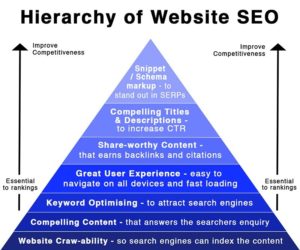INTRODUCTION
Welcome to your most comprehensive SEO learning journey!
You’ll get the most out of this guide if your desire to learn search engine optimization (SEO) is exceeded only by your willingness to execute and test concepts.
This guide is designed to describe all major aspects of SEO, from finding the terms and phrases (keywords) that can generate qualified traffic to your website, to making your site friendly to search engines, to building links and marketing the unique value of your site.
The world of search engine optimization is complex and ever-changing, but you can easily understand the basics, and even a small amount of SEO knowledge can make a big difference. Free SEO education is also widely available on the web, including in guides like this! (Woohoo!)
Combine this information with some practice and you are well on your way to becoming a savvy SEO.
The Basics of Search Engine Optimization
Ever heard of Maslow’s hierarchy of needs? It’s a theory of psychology that prioritizes the most fundamental human needs (like air, water, and physical safety) over more advanced needs (like esteem and social belonging). The theory is that you can’t achieve the needs at the top without ensuring the more fundamental needs are met first. Love doesn’t matter if you don’t have food.
Our founder, Rand Fishkin, made a similar pyramid to explain the way folks should go about SEO, and we’ve affectionately dubbed it “Mozlow’s hierarchy of SEO needs.”
Here’s what it looks like:

As you can see, the foundation of good SEO begins with ensuring crawl accessibility, and moves up from there.
Using this beginner’s guide, we can follow these seven steps to successful SEO:
- Crawl accessibility so engines can read your website
- Compelling content that answers the searcher’s query
- Keyword optimized to attract searchers & engines
- Great user experience including a fast load speed and compelling UX
- Share-worthy content that earns links, citations, and amplification
- Title, URL, & description to draw high CTR in the rankings
- Snippet/schema markup to stand out in SERPs
We’ll spend time on each of these areas throughout this guide, but we wanted to introduce it here because it offers a look at how we structured the guide as a whole.
Now we can explore the chapters…
Chapter 1: SEO 101
What is it and why it is important?
Chapter 2: How Search Engines Work – Crawling, Indexing, and Ranking
First, you need to show up.
Chapter 3: Keyword Research
Understand what your audience wants to find.
Chapter 4: On-site Optimization
Use your research to craft your message.
Chapter 5: Technical SEO
Basic technical knowledge will help you optimize your site for search engines and establish credibility with developers.
Chapter 6: Link Building
Turn up the volume.
Chapter 7: Measuring, Prioritizing, & Executing SEO
Set yourself up for success.
The SEO Glossary
Understand key terms and phrases.
How much of this guide do I need to read?
If you’re serious about improving search traffic and are unfamiliar with SEO, we recommend reading the Beginner’s Guide to SEO front-to-back. We’ve tried to make it as concise and easy to understand as possible, and learning the basics of SEO is a vital first step in achieving your online business goals.
Go through at the pace that suits you best, and be sure to take note of the dozens of resources we link to throughout the chapters — they’re also worthy of your attention.
Getting excited yet? You should be! Search engine marketing is a fascinating field and can be lots of fun! If you get confused, don’t give up; we have folks who can help you with instructor-led SEO training seminars.
We’re excited you’re here! Grab a cup of coffee, and let’s dive into Chapter 1 (SEO 101).

